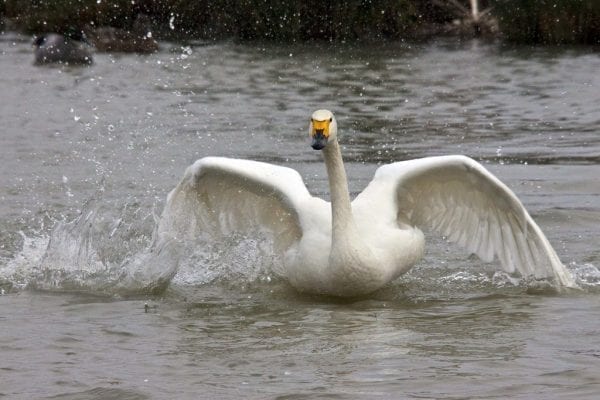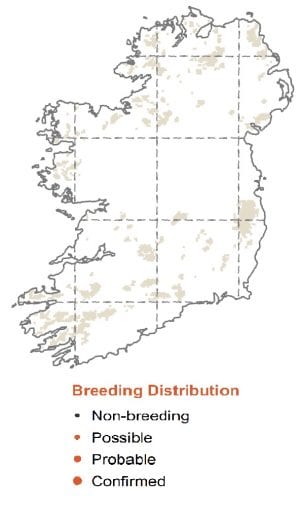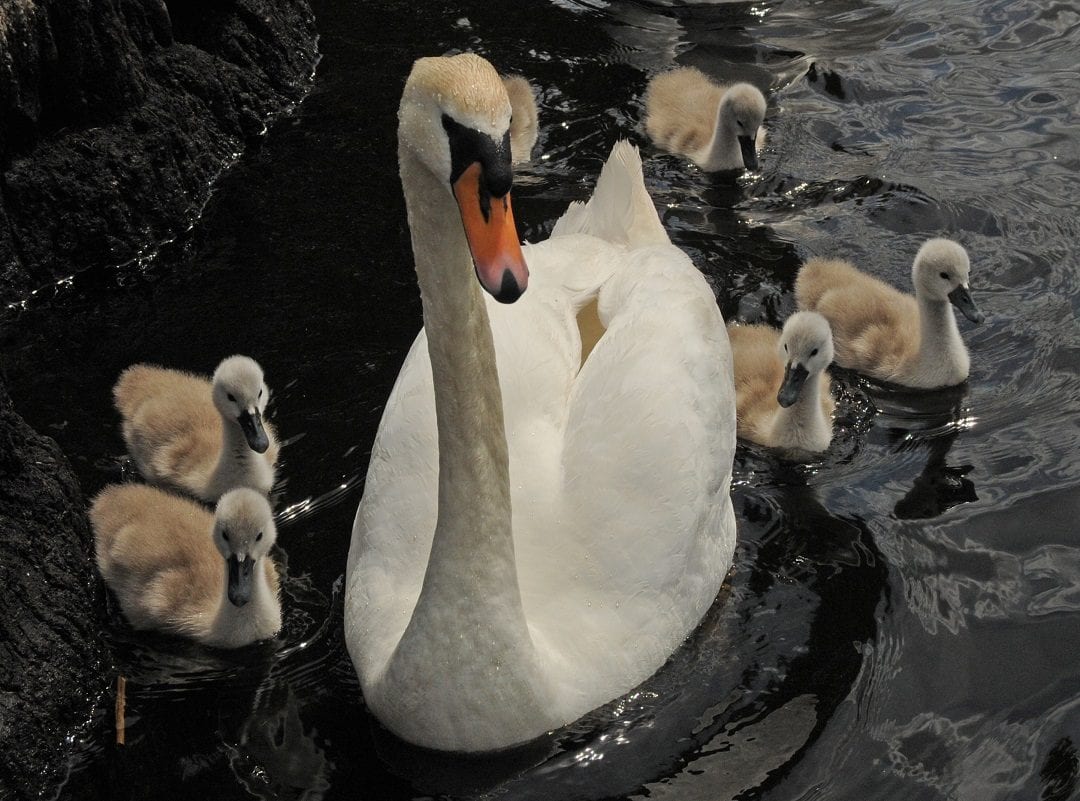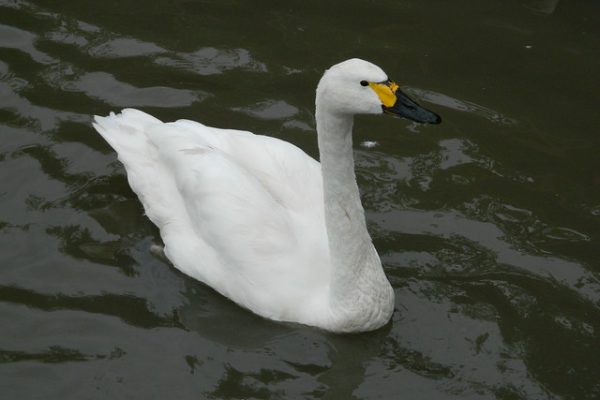
Bewick’s Swan
| Irish Name: | Eala Bewick |
| Scientific name: | Cygnus columbianus |
| Bird Family: | Swans |
red
Conservation status
Conservation status
Status
Increasingly rare winter visitor from Siberia from November to March at wetlands in Counties Wexford and around Lough Neagh.
Identification
Smallest of the three white swan species occurring in Ireland, with yellow and black bill (yellow at the base, usually rounded or square, and not reaching the nostril or extending along the sides, as in Whooper Swan). Neck also shorter than Whooper Swan.
Voice
Similar to Whooper Swan, but more yapping or honking and less buglings
Diet
Plant material including tubers, shoots and leaves and they forage in water or flooded pasture
Breeding
Breeds across low-lying open grassy or swampy tundra of Arctic Siberia adjacent to pools, lakes or rivers
Wintering
Low-lying wet pasture, lakes, ponds and stubble. The majority of the European population winters in Germany, the Netherlands and Britain. One of the potential reasons that the species has declined in Ireland is that Bewick's Swans find suitable sites in these countries and no longer need to fly as far west as Ireland.
Monitored by
Irish Wetland Bird Survey (I-WeBS). Swan census every five years, last in 2020.
Blog posts about this bird

Whooper Swan numbers in Ireland increase in new census results
A census carried out across the island of Ireland last year found that Whooper Swan numbers increased by 27%, while Bewick’s Swan look set to be lost from Ireland in the coming years.
The 8th International Swan Census took place in January 2020. The census is carried out over a single weekend every five years, where ornithologists and birdwatchers across Ireland set out to locate and count every Whooper Swan and Bewick’s Swan in the country. The aim of the census is to produce an updated population estimate for these species in Ireland. The survey was coordinated in the Republic of Ireland by BirdWatch Ireland as part of the Irish Wetland Bird Survey (I-WeBS) under contract to the National Parks and Wildlife Service (NPWS) of the Department of Housing, Local Government and Heritage.
Nearly 300 volunteer birdwatchers, as well as staff from BirdWatch Ireland and the National Parks and Wildlife Service, took part in the census, checking over 1,500 locations across the island of Ireland. A total of 19,111 Whooper Swans were recorded, 14,467 in the Republic of Ireland (ROI) and 4,644 in Northern Ireland (NI). This is the highest total ever recorded in Ireland and represents a 27% increase in the Whooper Swan population since the previous census in 2015.
 “Our Whooper Swans breed in Iceland during the summer and spend the winter in Ireland and Britain. Results from previous censuses had indicated that the Irish-wintering population of Whooper Swans was starting to plateau – growth had slowed, and numbers were largely stable in recent censuses, so we really weren’t expecting this level of increase” said Brian Burke of BirdWatch Ireland, who coordinated the survey in ROI. “They’re a species that is deep-rooted in Irish mythology, and still today they really captivate people right across the country when they arrive in the autumn, so we’re delighted to see them doing so well”.
In total, 550 flocks were recorded in Ireland, with largest numbers in counties Offaly, Galway, Roscommon and Donegal in ROI, and Derry and Antrim in NI. In ROI, wetlands along the River Shannon, and its lakes and tributaries form a stronghold for the species.
“Our Whooper Swans breed in Iceland during the summer and spend the winter in Ireland and Britain. Results from previous censuses had indicated that the Irish-wintering population of Whooper Swans was starting to plateau – growth had slowed, and numbers were largely stable in recent censuses, so we really weren’t expecting this level of increase” said Brian Burke of BirdWatch Ireland, who coordinated the survey in ROI. “They’re a species that is deep-rooted in Irish mythology, and still today they really captivate people right across the country when they arrive in the autumn, so we’re delighted to see them doing so well”.
In total, 550 flocks were recorded in Ireland, with largest numbers in counties Offaly, Galway, Roscommon and Donegal in ROI, and Derry and Antrim in NI. In ROI, wetlands along the River Shannon, and its lakes and tributaries form a stronghold for the species.
 Agricultural grassland is an important food source for our migratory swans and geese, and 74% of Whooper Swans were recorded feeding on improved and rough grassland during the census. “Pasture fields in close proximity to lakes and flooded rivers provide crucial feeding habitat for Whooper Swans, and any farmers I’ve met take great pride in hosting their local Whooper flock each winter” said Mr Burke.
“The recorded increase in the Irish Whooper Swan population is really encouraging. For a species like Whoopers to do well, conditions across its migratory range must be right. The census results suggest that conditions for Whooper Swans in both Ireland and Iceland, where they breed, are very suitable”, said Seán Kelly, Waterbird Ecologist with the National Parks and Wildlife Service. “We are grateful to all the volunteers across the country who participated in the swan census; without them it simply wouldn’t be possible to so carefully monitor these species”.
Agricultural grassland is an important food source for our migratory swans and geese, and 74% of Whooper Swans were recorded feeding on improved and rough grassland during the census. “Pasture fields in close proximity to lakes and flooded rivers provide crucial feeding habitat for Whooper Swans, and any farmers I’ve met take great pride in hosting their local Whooper flock each winter” said Mr Burke.
“The recorded increase in the Irish Whooper Swan population is really encouraging. For a species like Whoopers to do well, conditions across its migratory range must be right. The census results suggest that conditions for Whooper Swans in both Ireland and Iceland, where they breed, are very suitable”, said Seán Kelly, Waterbird Ecologist with the National Parks and Wildlife Service. “We are grateful to all the volunteers across the country who participated in the swan census; without them it simply wouldn’t be possible to so carefully monitor these species”.
 Minister of State for Heritage, Malcolm Noonan T.D, welcomed the report and paid tribute to all those involved: “I’m delighted to welcome the results from the recent Swan Census – the eighth such census in Ireland since the 1980s – which allows Ireland to robustly monitor swan populations,” he said. “Biodiversity data is so important and I’d like to send my sincere thanks to the dedicated volunteers around the country, as well as the all-important staff within NPWS and BirdWatch Ireland, without whom this census would not have been possible. The census shows the positive impact of the work done by farmers, landowners and NPWS staff within the NPWS Farm Plan Scheme to protect these beautiful birds, and highlights the value of the ‘Goose and Swan’ agri-environment measure in the Department of Agriculture, Food and the Marine’s GLAS scheme. I look forward to visiting some of the sites leading the way for Whooper Swan conservation, particularly the lands along the River Shannon and around the fantastic Wexford Wildfowl Reserve, when we are able to travel again.”
Minister of State for Heritage, Malcolm Noonan T.D, welcomed the report and paid tribute to all those involved: “I’m delighted to welcome the results from the recent Swan Census – the eighth such census in Ireland since the 1980s – which allows Ireland to robustly monitor swan populations,” he said. “Biodiversity data is so important and I’d like to send my sincere thanks to the dedicated volunteers around the country, as well as the all-important staff within NPWS and BirdWatch Ireland, without whom this census would not have been possible. The census shows the positive impact of the work done by farmers, landowners and NPWS staff within the NPWS Farm Plan Scheme to protect these beautiful birds, and highlights the value of the ‘Goose and Swan’ agri-environment measure in the Department of Agriculture, Food and the Marine’s GLAS scheme. I look forward to visiting some of the sites leading the way for Whooper Swan conservation, particularly the lands along the River Shannon and around the fantastic Wexford Wildfowl Reserve, when we are able to travel again.”
 The census revealed some sad news, however, in the continued decline of the Bewick’s Swan in Ireland.
Bewick’s Swans nest in Arctic Russia during the summer and winter in northern Europe, the UK and Ireland. As climate change has caused milder winters on the continent, many Bewick’s Swans have been ‘short-stopping’, that is, not flying as far as Ireland, simply because they don’t need to anymore. Migration is a hugely difficult undertaking, so they won’t burn through their energy and fat reserves if they don’t have to. This, coupled with declines in the size of the international Bewick’s Swan population, has seen the Irish contingent getting smaller and smaller each winter. Only 12 Bewick’s Swans were recorded in Ireland for the census – 11 in Wexford and a lone bird in Roscommon, and it’s expected that they will cease to occur in Ireland altogether in the near future.
Full details of the census results are due to be published in BirdWatch Ireland’s scientific journal Irish Birds later this year. A write-up of the results, including the totals for every county in Ireland, will be featured in the Spring 2021 issue of BirdWatch Ireland's Wings membership magazine. To become a member receive Wings four times per year, and support our work, see our different membership options here.
The census revealed some sad news, however, in the continued decline of the Bewick’s Swan in Ireland.
Bewick’s Swans nest in Arctic Russia during the summer and winter in northern Europe, the UK and Ireland. As climate change has caused milder winters on the continent, many Bewick’s Swans have been ‘short-stopping’, that is, not flying as far as Ireland, simply because they don’t need to anymore. Migration is a hugely difficult undertaking, so they won’t burn through their energy and fat reserves if they don’t have to. This, coupled with declines in the size of the international Bewick’s Swan population, has seen the Irish contingent getting smaller and smaller each winter. Only 12 Bewick’s Swans were recorded in Ireland for the census – 11 in Wexford and a lone bird in Roscommon, and it’s expected that they will cease to occur in Ireland altogether in the near future.
Full details of the census results are due to be published in BirdWatch Ireland’s scientific journal Irish Birds later this year. A write-up of the results, including the totals for every county in Ireland, will be featured in the Spring 2021 issue of BirdWatch Ireland's Wings membership magazine. To become a member receive Wings four times per year, and support our work, see our different membership options here.
 “Our Whooper Swans breed in Iceland during the summer and spend the winter in Ireland and Britain. Results from previous censuses had indicated that the Irish-wintering population of Whooper Swans was starting to plateau – growth had slowed, and numbers were largely stable in recent censuses, so we really weren’t expecting this level of increase” said Brian Burke of BirdWatch Ireland, who coordinated the survey in ROI. “They’re a species that is deep-rooted in Irish mythology, and still today they really captivate people right across the country when they arrive in the autumn, so we’re delighted to see them doing so well”.
In total, 550 flocks were recorded in Ireland, with largest numbers in counties Offaly, Galway, Roscommon and Donegal in ROI, and Derry and Antrim in NI. In ROI, wetlands along the River Shannon, and its lakes and tributaries form a stronghold for the species.
“Our Whooper Swans breed in Iceland during the summer and spend the winter in Ireland and Britain. Results from previous censuses had indicated that the Irish-wintering population of Whooper Swans was starting to plateau – growth had slowed, and numbers were largely stable in recent censuses, so we really weren’t expecting this level of increase” said Brian Burke of BirdWatch Ireland, who coordinated the survey in ROI. “They’re a species that is deep-rooted in Irish mythology, and still today they really captivate people right across the country when they arrive in the autumn, so we’re delighted to see them doing so well”.
In total, 550 flocks were recorded in Ireland, with largest numbers in counties Offaly, Galway, Roscommon and Donegal in ROI, and Derry and Antrim in NI. In ROI, wetlands along the River Shannon, and its lakes and tributaries form a stronghold for the species.
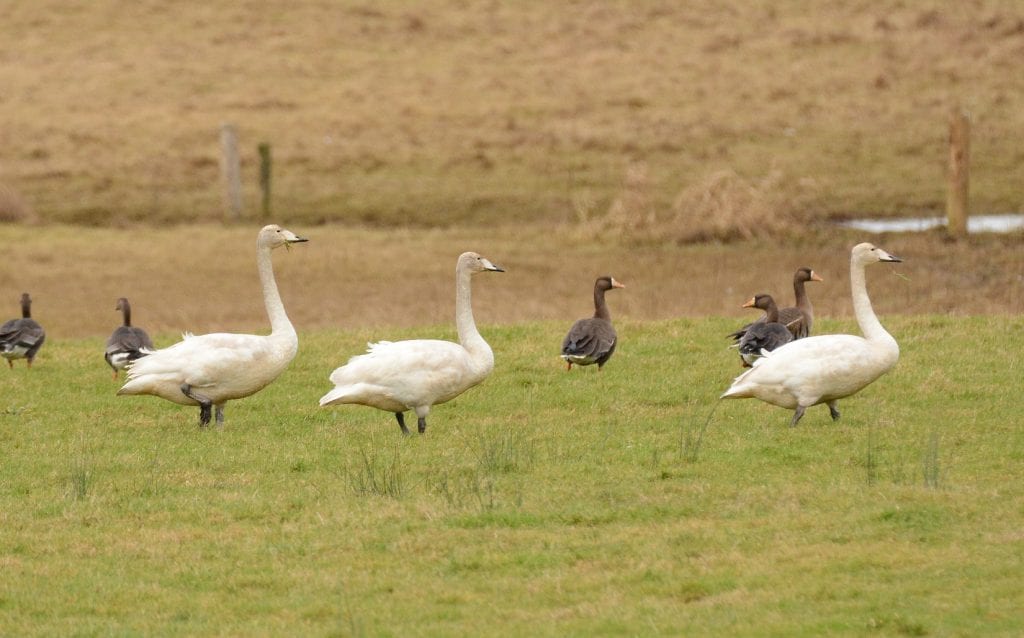 Agricultural grassland is an important food source for our migratory swans and geese, and 74% of Whooper Swans were recorded feeding on improved and rough grassland during the census. “Pasture fields in close proximity to lakes and flooded rivers provide crucial feeding habitat for Whooper Swans, and any farmers I’ve met take great pride in hosting their local Whooper flock each winter” said Mr Burke.
“The recorded increase in the Irish Whooper Swan population is really encouraging. For a species like Whoopers to do well, conditions across its migratory range must be right. The census results suggest that conditions for Whooper Swans in both Ireland and Iceland, where they breed, are very suitable”, said Seán Kelly, Waterbird Ecologist with the National Parks and Wildlife Service. “We are grateful to all the volunteers across the country who participated in the swan census; without them it simply wouldn’t be possible to so carefully monitor these species”.
Agricultural grassland is an important food source for our migratory swans and geese, and 74% of Whooper Swans were recorded feeding on improved and rough grassland during the census. “Pasture fields in close proximity to lakes and flooded rivers provide crucial feeding habitat for Whooper Swans, and any farmers I’ve met take great pride in hosting their local Whooper flock each winter” said Mr Burke.
“The recorded increase in the Irish Whooper Swan population is really encouraging. For a species like Whoopers to do well, conditions across its migratory range must be right. The census results suggest that conditions for Whooper Swans in both Ireland and Iceland, where they breed, are very suitable”, said Seán Kelly, Waterbird Ecologist with the National Parks and Wildlife Service. “We are grateful to all the volunteers across the country who participated in the swan census; without them it simply wouldn’t be possible to so carefully monitor these species”.
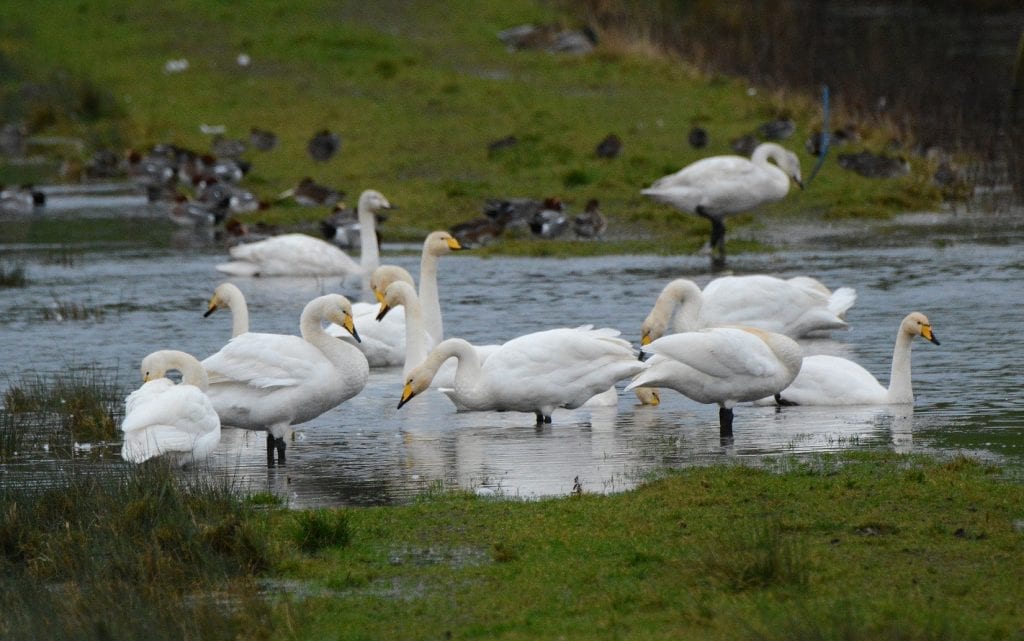 Minister of State for Heritage, Malcolm Noonan T.D, welcomed the report and paid tribute to all those involved: “I’m delighted to welcome the results from the recent Swan Census – the eighth such census in Ireland since the 1980s – which allows Ireland to robustly monitor swan populations,” he said. “Biodiversity data is so important and I’d like to send my sincere thanks to the dedicated volunteers around the country, as well as the all-important staff within NPWS and BirdWatch Ireland, without whom this census would not have been possible. The census shows the positive impact of the work done by farmers, landowners and NPWS staff within the NPWS Farm Plan Scheme to protect these beautiful birds, and highlights the value of the ‘Goose and Swan’ agri-environment measure in the Department of Agriculture, Food and the Marine’s GLAS scheme. I look forward to visiting some of the sites leading the way for Whooper Swan conservation, particularly the lands along the River Shannon and around the fantastic Wexford Wildfowl Reserve, when we are able to travel again.”
Minister of State for Heritage, Malcolm Noonan T.D, welcomed the report and paid tribute to all those involved: “I’m delighted to welcome the results from the recent Swan Census – the eighth such census in Ireland since the 1980s – which allows Ireland to robustly monitor swan populations,” he said. “Biodiversity data is so important and I’d like to send my sincere thanks to the dedicated volunteers around the country, as well as the all-important staff within NPWS and BirdWatch Ireland, without whom this census would not have been possible. The census shows the positive impact of the work done by farmers, landowners and NPWS staff within the NPWS Farm Plan Scheme to protect these beautiful birds, and highlights the value of the ‘Goose and Swan’ agri-environment measure in the Department of Agriculture, Food and the Marine’s GLAS scheme. I look forward to visiting some of the sites leading the way for Whooper Swan conservation, particularly the lands along the River Shannon and around the fantastic Wexford Wildfowl Reserve, when we are able to travel again.”
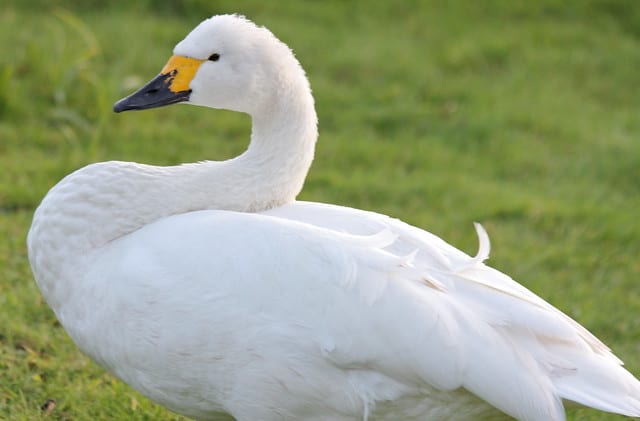 The census revealed some sad news, however, in the continued decline of the Bewick’s Swan in Ireland.
Bewick’s Swans nest in Arctic Russia during the summer and winter in northern Europe, the UK and Ireland. As climate change has caused milder winters on the continent, many Bewick’s Swans have been ‘short-stopping’, that is, not flying as far as Ireland, simply because they don’t need to anymore. Migration is a hugely difficult undertaking, so they won’t burn through their energy and fat reserves if they don’t have to. This, coupled with declines in the size of the international Bewick’s Swan population, has seen the Irish contingent getting smaller and smaller each winter. Only 12 Bewick’s Swans were recorded in Ireland for the census – 11 in Wexford and a lone bird in Roscommon, and it’s expected that they will cease to occur in Ireland altogether in the near future.
Full details of the census results are due to be published in BirdWatch Ireland’s scientific journal Irish Birds later this year. A write-up of the results, including the totals for every county in Ireland, will be featured in the Spring 2021 issue of BirdWatch Ireland's Wings membership magazine. To become a member receive Wings four times per year, and support our work, see our different membership options here.
The census revealed some sad news, however, in the continued decline of the Bewick’s Swan in Ireland.
Bewick’s Swans nest in Arctic Russia during the summer and winter in northern Europe, the UK and Ireland. As climate change has caused milder winters on the continent, many Bewick’s Swans have been ‘short-stopping’, that is, not flying as far as Ireland, simply because they don’t need to anymore. Migration is a hugely difficult undertaking, so they won’t burn through their energy and fat reserves if they don’t have to. This, coupled with declines in the size of the international Bewick’s Swan population, has seen the Irish contingent getting smaller and smaller each winter. Only 12 Bewick’s Swans were recorded in Ireland for the census – 11 in Wexford and a lone bird in Roscommon, and it’s expected that they will cease to occur in Ireland altogether in the near future.
Full details of the census results are due to be published in BirdWatch Ireland’s scientific journal Irish Birds later this year. A write-up of the results, including the totals for every county in Ireland, will be featured in the Spring 2021 issue of BirdWatch Ireland's Wings membership magazine. To become a member receive Wings four times per year, and support our work, see our different membership options here.


